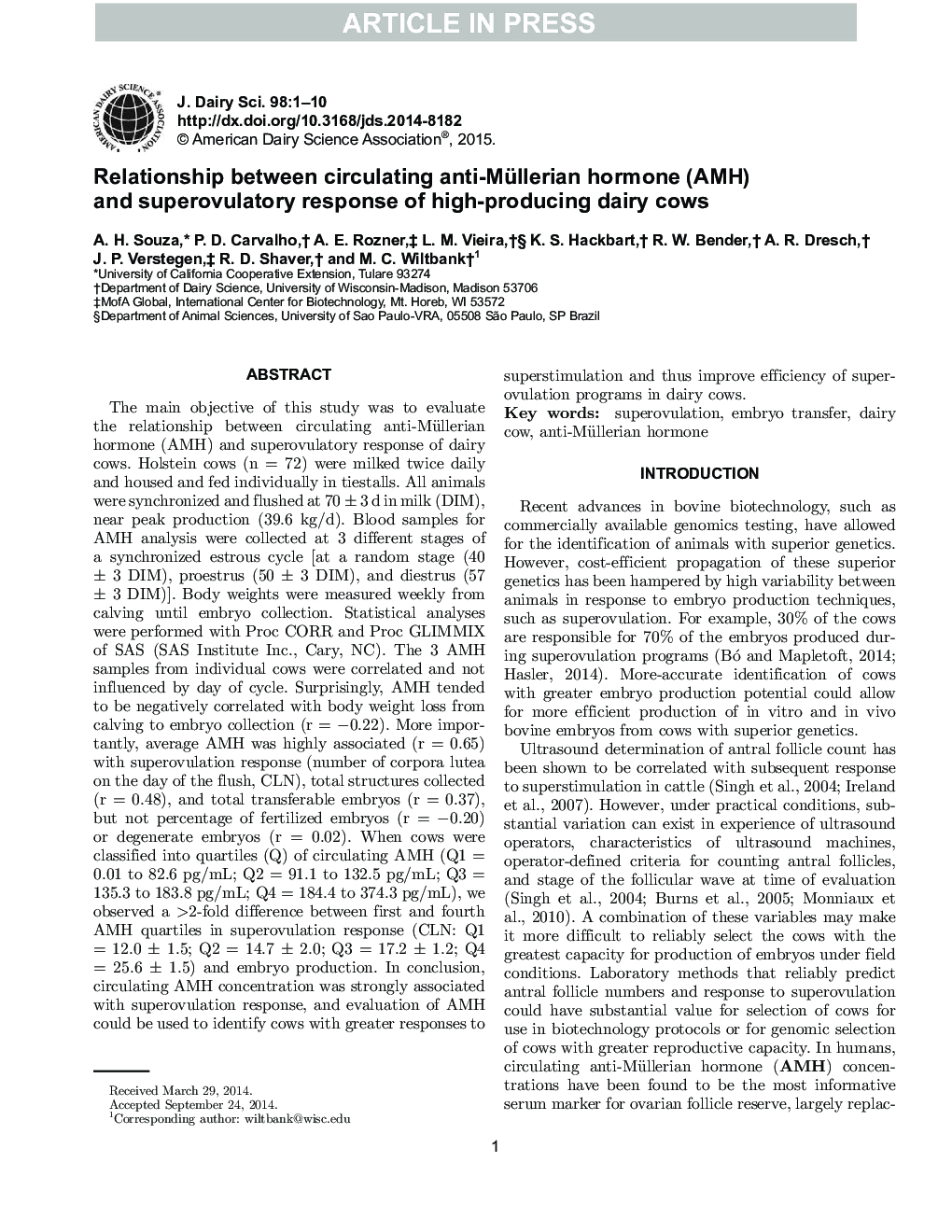| کد مقاله | کد نشریه | سال انتشار | مقاله انگلیسی | نسخه تمام متن |
|---|---|---|---|---|
| 10973765 | 1108019 | 2015 | 10 صفحه PDF | دانلود رایگان |
عنوان انگلیسی مقاله ISI
Relationship between circulating anti-Müllerian hormone (AMH) and superovulatory response of high-producing dairy cows
دانلود مقاله + سفارش ترجمه
دانلود مقاله ISI انگلیسی
رایگان برای ایرانیان
کلمات کلیدی
موضوعات مرتبط
علوم زیستی و بیوفناوری
علوم کشاورزی و بیولوژیک
علوم دامی و جانورشناسی
پیش نمایش صفحه اول مقاله

چکیده انگلیسی
The main objective of this study was to evaluate the relationship between circulating anti-Müllerian hormone (AMH) and superovulatory response of dairy cows. Holstein cows (n = 72) were milked twice daily and housed and fed individually in tiestalls. All animals were synchronized and flushed at 70 ± 3 d in milk (DIM), near peak production (39.6 kg/d). Blood samples for AMH analysis were collected at 3 different stages of a synchronized estrous cycle [at a random stage (40 ± 3 DIM), proestrus (50 ± 3 DIM), and diestrus (57 ± 3 DIM)]. Body weights were measured weekly from calving until embryo collection. Statistical analyses were performed with Proc CORR and Proc GLIMMIX of SAS (SAS Institute Inc., Cary, NC). The 3 AMH samples from individual cows were correlated and not influenced by day of cycle. Surprisingly, AMH tended to be negatively correlated with body weight loss from calving to embryo collection (r = â0.22). More importantly, average AMH was highly associated (r = 0.65) with superovulation response (number of corpora lutea on the day of the flush, CLN), total structures collected (r = 0.48), and total transferable embryos (r = 0.37), but not percentage of fertilized embryos (r = â0.20) or degenerate embryos (r = 0.02). When cows were classified into quartiles (Q) of circulating AMH (Q1 = 0.01 to 82.6 pg/mL; Q2 = 91.1 to 132.5 pg/mL; Q3 = 135.3 to 183.8 pg/mL; Q4 = 184.4 to 374.3 pg/mL), we observed a >2-fold difference between first and fourth AMH quartiles in superovulation response (CLN: Q1 = 12.0 ± 1.5; Q2 = 14.7 ± 2.0; Q3 = 17.2 ± 1.2; Q4 = 25.6 ± 1.5) and embryo production. In conclusion, circulating AMH concentration was strongly associated with superovulation response, and evaluation of AMH could be used to identify cows with greater responses to superstimulation and thus improve efficiency of superovulation programs in dairy cows.
ناشر
Database: Elsevier - ScienceDirect (ساینس دایرکت)
Journal: Journal of Dairy Science - Volume 98, Issue 1, January 2015, Pages 169-178
Journal: Journal of Dairy Science - Volume 98, Issue 1, January 2015, Pages 169-178
نویسندگان
A.H. Souza, P.D. Carvalho, A.E. Rozner, L.M. Vieira, K.S. Hackbart, R.W. Bender, A.R. Dresch, J.P. Verstegen, R.D. Shaver, M.C. Wiltbank,